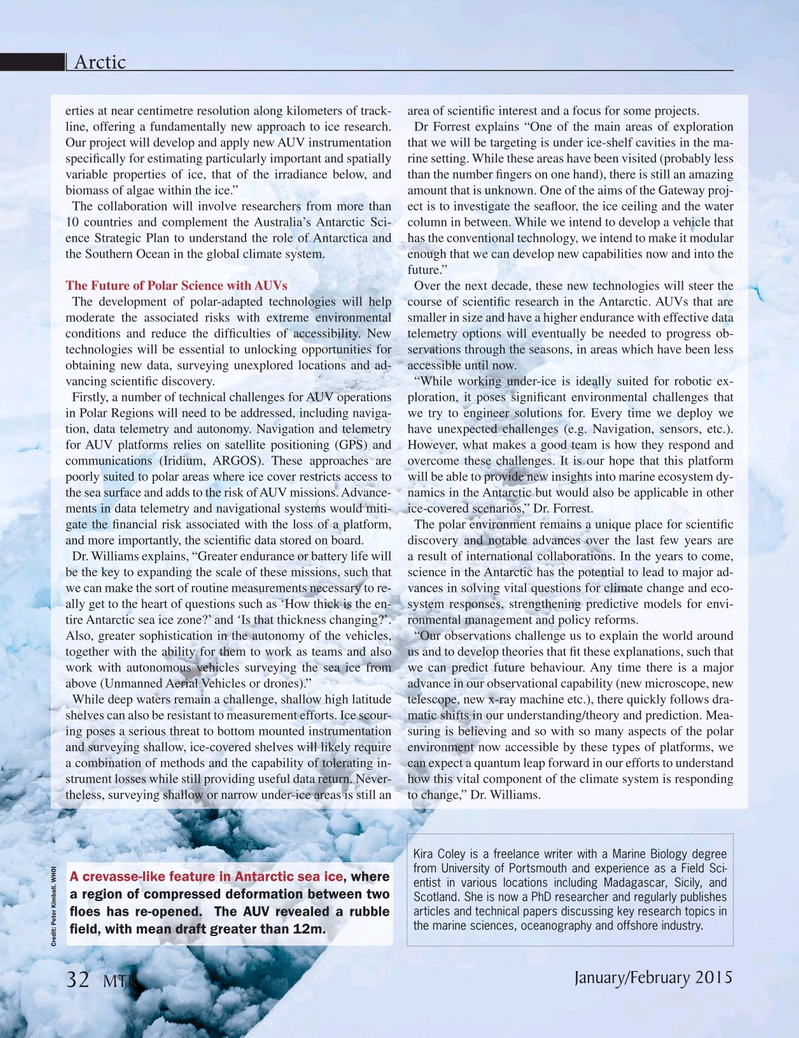
Page 32: of Marine Technology Magazine (January 2015)
Underwater Vehicle Annual: ROV, AUV, and UUVs
Read this page in Pdf, Flash or Html5 edition of January 2015 Marine Technology Magazine
Arctic erties at near centimetre resolution along kilometers of track- area of scienti? c interest and a focus for some projects.
line, offering a fundamentally new approach to ice research. Dr Forrest explains “One of the main areas of exploration
Our project will develop and apply new AUV instrumentation that we will be targeting is under ice-shelf cavities in the ma- speci? cally for estimating particularly important and spatially rine setting. While these areas have been visited (probably less variable properties of ice, that of the irradiance below, and than the number ? ngers on one hand), there is still an amazing biomass of algae within the ice.” amount that is unknown. One of the aims of the Gateway proj-
The collaboration will involve researchers from more than ect is to investigate the sea? oor, the ice ceiling and the water 10 countries and complement the Australia’s Antarctic Sci- column in between. While we intend to develop a vehicle that ence Strategic Plan to understand the role of Antarctica and has the conventional technology, we intend to make it modular the Southern Ocean in the global climate system. enough that we can develop new capabilities now and into the future.”
The Future of Polar Science with AUVs Over the next decade, these new technologies will steer the
The development of polar-adapted technologies will help course of scienti? c research in the Antarctic. AUVs that are moderate the associated risks with extreme environmental smaller in size and have a higher endurance with effective data conditions and reduce the dif? culties of accessibility. New telemetry options will eventually be needed to progress ob- technologies will be essential to unlocking opportunities for servations through the seasons, in areas which have been less obtaining new data, surveying unexplored locations and ad- accessible until now.
vancing scienti? c discovery. “While working under-ice is ideally suited for robotic ex-
Firstly, a number of technical challenges for AUV operations ploration, it poses signi? cant environmental challenges that in Polar Regions will need to be addressed, including naviga- we try to engineer solutions for. Every time we deploy we tion, data telemetry and autonomy. Navigation and telemetry have unexpected challenges (e.g. Navigation, sensors, etc.). for AUV platforms relies on satellite positioning (GPS) and However, what makes a good team is how they respond and communications (Iridium, ARGOS). These approaches are overcome these challenges. It is our hope that this platform poorly suited to polar areas where ice cover restricts access to will be able to provide new insights into marine ecosystem dy- the sea surface and adds to the risk of AUV missions. Advance- namics in the Antarctic but would also be applicable in other ments in data telemetry and navigational systems would miti- ice-covered scenarios,” Dr. Forrest.
gate the ? nancial risk associated with the loss of a platform, The polar environment remains a unique place for scienti? c and more importantly, the scienti? c data stored on board. discovery and notable advances over the last few years are
Dr. Williams explains, “Greater endurance or battery life will a result of international collaborations. In the years to come, be the key to expanding the scale of these missions, such that science in the Antarctic has the potential to lead to major ad- we can make the sort of routine measurements necessary to re- vances in solving vital questions for climate change and eco- ally get to the heart of questions such as ‘How thick is the en- system responses, strengthening predictive models for envi- tire Antarctic sea ice zone?’ and ‘Is that thickness changing?’. ronmental management and policy reforms.
Also, greater sophistication in the autonomy of the vehicles, “Our observations challenge us to explain the world around together with the ability for them to work as teams and also us and to develop theories that ? t these explanations, such that work with autonomous vehicles surveying the sea ice from we can predict future behaviour. Any time there is a major above (Unmanned Aerial Vehicles or drones).” advance in our observational capability (new microscope, new
While deep waters remain a challenge, shallow high latitude telescope, new x-ray machine etc.), there quickly follows dra- shelves can also be resistant to measurement efforts. Ice scour- matic shifts in our understanding/theory and prediction. Mea- ing poses a serious threat to bottom mounted instrumentation suring is believing and so with so many aspects of the polar and surveying shallow, ice-covered shelves will likely require environment now accessible by these types of platforms, we a combination of methods and the capability of tolerating in- can expect a quantum leap forward in our efforts to understand strument losses while still providing useful data return. Never- how this vital component of the climate system is responding theless, surveying shallow or narrow under-ice areas is still an to change,” Dr. Williams.
Kira Coley is a freelance writer with a Marine Biology degree from University of Portsmouth and experience as a Field Sci-
A crevasse-like feature in Antarctic sea ice, where entist in various locations including Madagascar, Sicily, and a region of compressed deformation between two
Scotland. She is now a PhD researcher and regularly publishes articles and technical papers discussing key research topics in ? oes has re-opened. The AUV revealed a rubble the marine sciences, oceanography and offshore industry.
? eld, with mean draft greater than 12m.
Credit: Peter Kimball, WHOI
January/February 2015 32 MTR
MTR #1 (18-33).indd 32 MTR #1 (18-33).indd 32 2/2/2015 3:21:27 PM2/2/2015 3:21:27 PM

 31
31

 33
33
